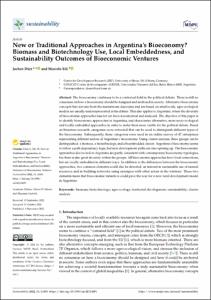New or Traditional Approaches in Argentina's Bioeconomy?Biomass and Biotechnology Use, Local Embeddedness, and Sustainability Outcomes of Bioeconomic Ventures

New or Traditional Approaches in Argentina's Bioeconomy?
Biomass and Biotechnology Use, Local Embeddedness, and Sustainability Outcomes of Bioeconomic Ventures

| dc.contributor.author | Dürr, Jochen | |
| dc.contributor.author | Sili, Marcelo | |
| dc.date.accessioned | 2023-04-28T10:07:09Z | |
| dc.date.available | 2023-04-28T10:07:09Z | |
| dc.date.issued | 04.11.2022 | |
| dc.identifier.uri | https://hdl.handle.net/20.500.11811/10794 | |
| dc.description.abstract | The bioeconomy continues to be a contested field in the political debate. There is still no consensus on how a bioeconomy should be designed and anchored in society. Alternative bioeconomy concepts that deviate from the mainstream discourse and are based on small-scale, agro-ecological models are usually underrepresented in the debate. This also applies to Argentina, where the diversity of bioeconomic approaches has not yet been documented and analyzed. The objective of this paper is to identify bioeconomic approaches in Argentina, and characterize alternative, more socio-ecological and locally embedded approaches in order to make them more visible for the political debate. Based on literature research, categories were extracted that can be used to distinguish different types of the bioeconomy. Subsequently, these categories were used in an online survey of 47 enterprises representing different sectors of Argentina’s bioeconomy. Using cluster analysis, three groups can be distinguished: a biomass, a biotechnology, and a bioembedded cluster. Argentina’s bioeconomy seems to follow a path dependency logic, but new development paths are also opening up. The bioeconomic approaches discovered in Argentina are partly consistent with contemporary bioeconomy typologies, but there is also great diversity within the groups. All bioeconomic approaches have local connections, but are locally embedded in different ways. In addition to the differences between the bioeconomic approaches, two common elements could also be detected: an interest in sustainable use of natural resources and in building networks using synergies with other actors in the territory. These two elements mean that bioeconomic initiatives could pave the way for a new rural development model in Argentina. | en |
| dc.format.extent | 28 | |
| dc.language.iso | eng | |
| dc.rights | Namensnennung 4.0 International | |
| dc.rights.uri | http://creativecommons.org/licenses/by/4.0/ | |
| dc.subject | biomass | |
| dc.subject | biotechnology | |
| dc.subject | agro-ecology | |
| dc.subject | territorial development | |
| dc.subject | sustainability | |
| dc.subject | cluster analysis | |
| dc.subject.ddc | 333.7 Natürliche Ressourcen, Energie und Umwelt | |
| dc.title | New or Traditional Approaches in Argentina's Bioeconomy? | |
| dc.title.alternative | Biomass and Biotechnology Use, Local Embeddedness, and Sustainability Outcomes of Bioeconomic Ventures | |
| dc.type | Wissenschaftlicher Artikel | |
| dc.publisher.name | MDPI | |
| dc.rights.accessRights | openAccess | |
| dcterms.bibliographicCitation.volume | 2022, vol. 14 | |
| dcterms.bibliographicCitation.issue | 21 | |
| dcterms.bibliographicCitation.pagestart | 1 | |
| dcterms.bibliographicCitation.pageend | 28 | |
| dc.relation.doi | https://doi.org/10.3390/su142114491 | |
| dcterms.bibliographicCitation.journaltitle | Sustainability | |
| ulbbn.pubtype | Zweitveröffentlichung | |
| dc.version | publishedVersion | |
| ulbbn.sponsorship.oaUnifund | OA-Förderung Universität Bonn |
Dateien zu dieser Ressource
Das Dokument erscheint in:
-
Publikationen (33)




